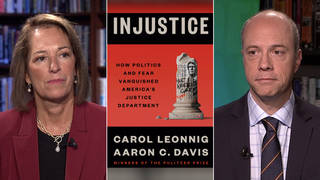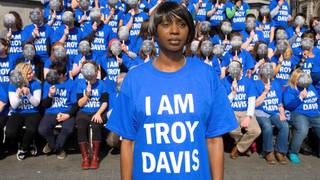
Guests
- Linda Geffinwas the second-chair prosecutor who helped win the death sentence for Duane Buck in 1997. She now opposes Buck’s execution. She is currently senior assistant prosecutor in the Harris County attorney’s office.
- Christina Swarnsis part of Duane Buck’s legal defense team and is the director of the NAACP Legal Defense Fund’s Criminal Justice Project.
Although Duane Buck’s guilt is not in question for the 1995 murder of his former girlfriend Debra Gardner and her friend Kenneth Butler, critics say jurors in his case were led to choose a death sentence over life without parole based on testimony of a state psychologist who argued that African-American criminals are more likely to pose a future danger to the public. We’re joined by two guests: Linda Geffin, the second-chair prosecutor who helped win Buck’s death sentence in 1997, but now opposes his execution, and Christina Swarns, an attorney with Duane Buck’s legal defense team and director of the NAACP Legal Defense Fund’s Criminal Justice Project. [includes rush transcript]
Transcript
AMY GOODMAN: We continue to look at Texas now, turning to a man facing execution there despite concerns he was sentenced to death because he’s black. Although Duane Buck’s guilt is not in question for the 1995 murder of his former girlfriend, Debra Gardner, and her friend, critics say jurors in his case were led to choose a death sentence over life without parole based on testimony of a state psychologist who argued African-American criminals are more likely to pose a future danger to the public. At a sentencing hearing in May 1997, Walter Quijano, a former chief psychologist for the state prison system who had evaluated Buck, testified, in part, that, quote, “It’s a sad commentary that minorities, Hispanics and black people, are overrepresented in the criminal justice system,” unquote.
In 2000, then-Texas Attorney General John Cornyn said Buck’s sentence and [five] other cases merited re-examination because of racially charged statements made by Quijano. But unlike all five of the other cases, Buck’s case was never reopened. Now the district attorney in Harris County has vowed to set an execution date within 30 days if Duane Buck loses his final appeal, which could be decided any day now. Last week, a statement calling for a new sentencing hearing for Buck was delivered to the Harris County district attorney, Mike Anderson, by Mark W. White Jr., former Texas governor in the '80s who oversaw 19 executions but opposes Buck's killing.
For more, we go to Houston, where we’re joined by Linda Geffin, second-chair prosecutor who helped win the death sentence for Duane Buck in '97. She now opposes his execution. She is currently senior assistant prosecutor in Harris County attorney's office. And here in New York, we’re joined by Christina Swarns, attorney who’s part of Duane Buck’s legal defense team. She is the director of the NAACP Legal Defense Fund’s Criminal Justice Project.
We welcome you both to Democracy Now! Linda Geffin, let’s go to you. You helped convict Duane Buck. He ended up with the death penalty, being sentenced to death. Why have you changed your view on his case right now?
LINDA GEFFIN: Fourteen years after the trial, I saw on the Internet the offensive testimony in black and white. And when I had the opportunity to read it and to really absorb what it was saying, it was so—I had so much clarity that it was racially offensive, it was egregious, and it was error. So I emailed Mr. Buck’s lawyer and asked how I could help.
AMY GOODMAN: Talk about what that quote was. I’ll read a comment Dr. Quijano made to The New York Times. He said, quote, “I was asked a question whether there is a relationship between race and violence or dangerousness. The literature suggests that there is a correlation. So I had to say yes.” He added, “It’s not because of the blackness of the person that is causing the violence. It is what goes with it. Poverty, the exposure to lack of education, exposure to criminal elements.” Let’s go to our guest right here in New York, Christina Swarns. Your response to that?
CHRISTINA SWARNS: Well, I think Dr. Quijano made quite clear that what he believed and what the state was looking for him to say was that because Mr. Buck was and is African American, he posed a future danger to society. And the prosecution, in cross-examination, elicited that testimony. They then went on to argue specifically that point during closing argument. What the prosecutor said in closing was: Dr. Quijano testified that he would pose a future danger, and that—on that basis, you should find that he is a future danger, and he should be sentenced to death. I would go on to say that, as The New York Times reported, Dr. Quijano’s opinion, of course, about this is false: There isn’t a real connection to support a future dangerousness finding.
AMY GOODMAN: Now, explain, Linda, in Houston, Texas—can you explain what it is that happened, that six cases where Quijano’s testimony was involved were all re-evaluated; five of them, those prisoners who were on death row, ended up with life without parole, except for the case of Duane Buck? What happened?
LINDA GEFFIN: It appears that then-Attorney General John Cornyn became aware of the racial bias that had infected these cases, and he ordered a review of all of these cases that Dr. Quijano testified in. And each case, he gave an opinion that they need a resentencing hearing. And all of them received their hearing except for Mr. Buck. And it’s likely, or it seems probable, that that happened because AG Cornyn was at the end of his term. He went on to do other things. The next AG, Greg Abbott, came in and—
AMY GOODMAN: AG Cornyn, of course, is the current senator from Texas, John Cornyn.
LINDA GEFFIN: That is true. That is true. And the current AG, Greg Abbott, did not grant the resentencing or recommend the resentencing hearing. It clearly looks that Mr. Buck’s case fell through the cracks, which is even more egregious when it’s a capital case. No case, no individual, no defendant should ever fall through the cracks of the criminal justice system, but when the ultimate punishment is on the line, it is morally reprehensible.
AMY GOODMAN: I want to read from a summary of a study by criminologist Raymond Paternoster that documented racial disparities in Harris County death penalty cases at the time Duane Buck was sentenced to death. He said the likelihood that the district attorney would pursue the death penalty against African defendants was about twice as high as for white defendants, and that, quote, “the probability that a jury would impose a death sentence was .33 in white defendant cases and increased to .438 for Black defendants,” 1.3 times higher than for white defendants. Christina Swarns, your response?
CHRISTINA SWARNS: Yeah, absolutely. I think that what we found was that the incidence of Dr. Quijano in presenting racially biased testimony at this trial was part of a—it seems to be part of a larger culture. Professor Paternoster found that the Harris County district attorney’s office was three times more likely to seek death for African-American offenders like Mr. Buck than they were for similarly situated white offenders, and that Harris County juries were twice as likely to sentence African-American offenders like Duane Buck to death relative to similarly situated white defendants. So it’s clear that this was sort of a larger pattern of discrimination against African Americans coming out of Harris County. And I would say that that’s also further supported by the history in the county. We know that the Harris County district attorney’s office disproportionately excluded African-American prospective jurors also at the time of Mr. Buck’s trial. So, there’s a lot of evidence, really, of discrimination against African Americans by that office at the time of Mr. Buck’s trial.
AMY GOODMAN: I want to play a comment from Phyllis Taylor, Duane Buck’s stepsister. She has forgiven Buck for shooting her on the same day of the murder of his ex-girlfriend and her friend and has called for his life to be spared. In this clip, she describes a recent visit she made to Duane Buck.
PHYLLIS TAYLOR: He came down from death row to receive his lethal injection sentencing at the county jail. And his sister Monique and I went to visit, and I had a wonderful visit with him. I let him know that, through everything that had happened, I found forgiveness within my heart. I went to church, and I prayed, along with family members and my pastor, until I found it in my heart to forgive. So, when I was able to talk back with him or through letters of writing, then I let him know that he was forgiven through Christ.
AMY GOODMAN: That is Duane Buck’s stepsister, Phyllis Taylor. The significance of this, Linda Geffin in Houston, of one of his victims—she wasn’t killed—forgiving him?
LINDA GEFFIN: I think it’s unprecedented. It’s huge. Most victims and victims’ families of these types of crimes are often out for revenge. But the fact that she was shot in the chest, recovered and has found it in her heart to forgive him is extremely significant.
Look, Harris County has the unfortunate reputation of being the death penalty capital of the world. Now we have a golden moment for Harris County to stand for justice. Phyllis Taylor has forgiven him. There are many elected officials and people in this community who are supporting the new resentencing hearing. Clearly, as you said at the top, that we’re not asking for him to be released—that’s silly—just a new color-blind resentencing hearing.
AMY GOODMAN: I want to go to The Texas Tribune. I want to talk about his lawyer, Duane Buck’s lawyer. They said, “Jerry Guerinot is a Texas public defender noted for his involvement in numerous death penalty cases. In total, Guerinot has represented 39 clients facing capital punishment, of which 20 have received the death sentence. His record has attracted significant media controversy [concerning] his ability and the number of cases he was allowed to take on. However, Guerinot has maintained that judges routinely assigned him the most difficult and horrific cases, often involving multiple murders or the murder of a child. He has been dubbed the 'death penalty express,' ’America’s most lethal attorney’ and the 'undertaker for the state of Texas' by various media outlets.” You were up against him, Linda Geffin, in this case, as you prosecuted Duane Buck. Your response to his representation in the original trial?
LINDA GEFFIN: I can’t comment on the comments in The Texas Tribune. I know that he’s a very effective attorney. He had a co-counsel in that case. And I do believe he is frequently appointed to death penalty cases. Here in Harris County, you have to qualify to represent a defendant on a capital case. And he’s an effective attorney.
AMY GOODMAN: He gained international notoriety in 2009 when his client, Linda Carty, a British citizen charged with murder and sentenced to death, appealed her case to the Supreme Court, claiming incompetent legal counsel. According to a report in The New York Times, Guerinot met with her once for only 15 minutes before her trial. The case involving Carty drew much attention about Guerinot’s career. He no longer handles capital punishment cases. However, the Houston Chronicle reported Guerinot handled more than 2,000 criminal cases between 2007 and ’08—more than 12 times the caseload limit accepted by the National Legal Aid and Public Defender Association. Christina Swarns, can you comment further?
CHRISTINA SWARNS: Yeah, I think it’s quite clear that Mr. Guerinot provided Mr. Buck with inadequate representation in this case. Obviously, this is a man that stood by and allowed testimony suggesting that his client’s race formed the basis, an appropriate basis, of a finding—
AMY GOODMAN: He brought that—that psychologist onto the stand, right?
CHRISTINA SWARNS: He did. And then when the state elicited this specific link on cross-examination, he did not object. You know, he allowed this testimony to go before the jury in this case. I would add further that he also did an inadequate job in terms of representing Mr. Buck in presenting mitigating evidence. There was an abundance of evidence that the jury should have heard about Mr. Buck’s life, about his upbringing, about the adversity that he faced, that was absolutely available at the time of his trial but was not presented. Mr. Guerinot’s record, as described in the articles that you’ve talked about, as just recounted in the [Carty] case, is absolutely reflected also in Mr. Buck’s case.
AMY GOODMAN: And, Christina Swarns, you deal with the issue of the death penalty a lot with the NAACP Legal Defense Fund. How typical is this in terms of representation? And final comment on this case?
CHRISTINA SWARNS: In terms of Mr. Guerinot, it’s an unfortunate reality that capitally charged defendants in this country routinely receive poor counsel. That said, I think this case really is above and beyond the pale with respect to seeing someone facing execution because of the color of their skin. This is a case where that link has been made explicit. That argument was presented to a jury, and that—and the argument was found by the jury and credited by the jury, and this man is now on death row facing execution. Texas promised that no person with this kind of testimony would be executed, and Texas needs to live up to its promise. It needs to honor the promise it made to Mr. Buck, because no one should be executed because of the color of their skin. And if Mr. Buck is executed on that basis, then all of us should be worried.
AMY GOODMAN: So explain what happens now in the case of Duane Buck.
CHRISTINA SWARNS: The case is now in front of the Court of Criminal Appeals in Texas. We have filed an appeal on Mr. Buck’s behalf. The Court of Criminal Appeals will—can either remand our case to the district court for a hearing and further review of the claims that we’ve raised, or it can reject or dismiss or deny our appeal and send us—send Mr. Buck’s case to the Supreme Court.












Media Options